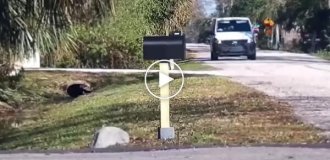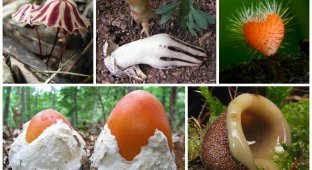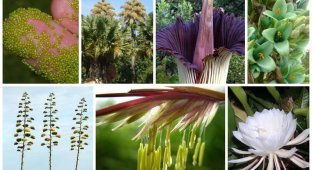While scientists are exploring space and looking for new animals in the ocean, flowers and mushrooms that look like alien organisms are growing right next to us.
1. African Hydnora (Hydnora africana)

Most of this plant is usually found underground. Hydnora parasitizes other plants and can take the necessary substances from them using suction cups (an excellent plot for a new film about aliens). Flowers that resemble huge claws appear rarely. They can only scare you in South Africa.
2. Red trellis (Clathrus ruber)

Not only does this mushroom look like an egg from which some kind of monster has hatched, but it also emits the smell of rotting flesh. It is very rare, so it definitely won’t scare you on a walk in the forest.
3. Bleeding Tooth (Hydnellum peckii)

The mushroom fully lives up to its name - it seems that the giant had a very unfortunate visit to the dentist. But the red droplets are not blood, but excess fluid that it secretes during growth. Despite the many legends that this mushroom has given rise to, it is not poisonous and odorless. But it is inedible due to its bitter taste.
4. Chinese mouse flower (Tacca chantrieri)

It looks more like a toothy monster with a long beard, rather than a harmless plant that can be found in Southeast Asia. And the flowers got their interesting nickname because their buds up close look like bats sleeping upside down.
5. Nepenthes (Pitcher Plant)

Although these terrifying “jaws” are truly carnivorous plants, they only feed on insects. Interestingly, the plants are used for roosting by bats, who are not afraid of parasites and nocturnal animals inside these small bags.
6. Porcupine Tomato

It seems that the needles of this plant absorb all the blood of those who were once pricked by them. Both the needles and the fruit contain toxic substances that are dangerous to humans. The Porcupine tomato is widespread in Madagascar and the Indian Ocean islands.
7. Cedar-Apple Rust Fungus

This growth, which looks like a hundred jelly tentacles, is the result of the influence of a pathogenic fungus. It appears on trees (apple trees, cedars and some types of juniper) and grows into an orange, shapeless mass directly from their leaves.
8. Brain cactus (Mammillaria elongata cristata)

In the photo - just a cactus, a subspecies of Mammillaria elongata. All plants are similar to the human brain, which is why they got their name.
9. Doll eyes (Actaea alba)

The plant is also known as wolfberry. Up close, it looks like there are not fruits on the branch, but creepy eyeballs strung on stems. Despite their scary appearance, they are not fatal to humans, but if eaten, they can cause vomiting and severe abdominal pain.
10. Dracula chimaera orchid

Do you also think you see a face? Sometimes the orchid is also called “monkey face” for its similarity. Interestingly, the flowers do not like the sun; they need to be grown in the shade (another plus for the vampire nickname).
11. Amorphophallus titanum

Amorphophallus has one of the largest inflorescences in the world. The plant is sometimes called the “corpse flower” because of the characteristic odor with which it attracts insects. In the countries of Indochina, the tubers of the plant are even eaten.
12. Annatto (Bixa orellana)

The opened annatto fruit looks like a jaw into which the monster has “imprisoned” the seeds. Interestingly, these seeds are used to make a natural food coloring that is often used to improve the appearance of dairy products. So when you buy yogurt or cheese at the supermarket, you may be choosing a product with annatto extract.
13. Rafflesia

Rafflesia is the largest flower in the world, it weighs up to 11 kg and its diameter reaches 1 m. It does not bloom for long, 3-4 days, and all this time it smells like rotting meat. This attracts flies, which rafflesia flowers need for pollination.
14. Buddha's Hand

It seems like these fruits are just trying to grab you. Although these are ordinary citrons, due to their genetic characteristics they have almost no pulp. Candied fruits are prepared from the fruits; the pulp is often added to salads and fish dishes. In East Asia, they are often used as a talisman and used to decorate homes and altars.
15. Lotus (Nelumbo)

Does it look like the many-eyed creature from ancient Greek myths? In fact, these are just lotus seeds, which are first formed in such “pots” and only then turn into beautiful buds.























